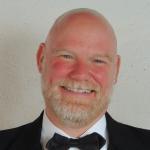Jeff Barnhart: Welcome! This month we’re taking a break from poring over recordings created 95+ years ago and concentrating on a Californian group that had its heyday in the 1950s and 1960s and greatly influenced my co-author. Hal, could you share your first impressions of the El Dorado Jazz Band as well as the elements that make this outfit unique? Then it’d be great if you could share who was in the band and lead us into the session we’ll be hearing this time around!
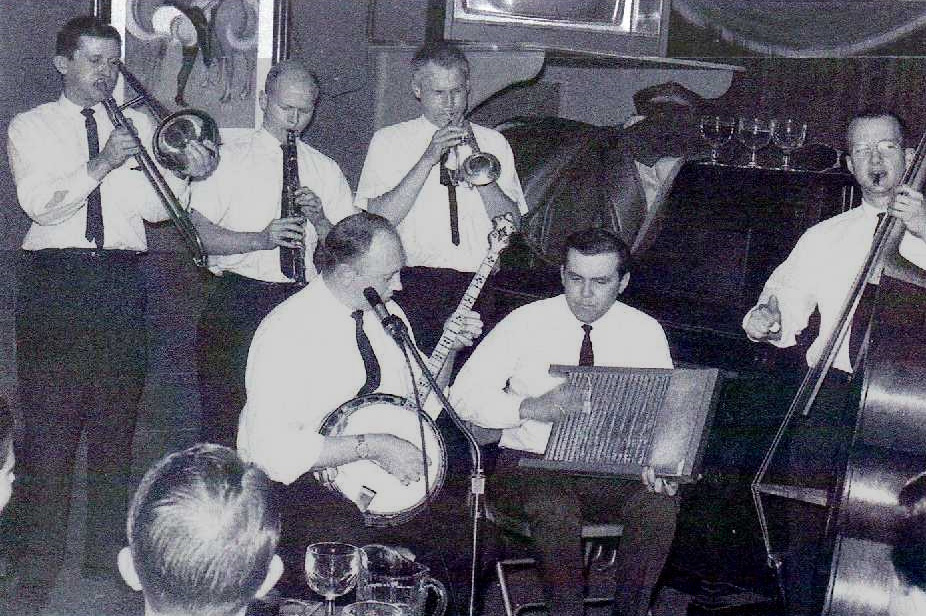
Hal Smith: Thanks, Jeff. To be clear, we are going to talk about the Southern California edition of the band, which was active from 1962 to 1966 (as opposed to the Northern California version, led by trombonist Jim Leigh, that performed from 1954-1961). The name of the group translates from Spanish to English as “The Golden” Jazz Band (thus the title for this month’s column)!
Even though the El Dorado is one of my favorite traditional jazz groups, I never heard the band in person! In 1966 I bought one of their LPs on the Epitaph label and was hooked on their sound immediately. The “Jazzologist” newsletter published by the New Orleans Jazz Club of California listed the venues where the band played in Orange and Los Angeles Counties. I’m sure that my parents would have taken me to one of the “kid-friendly” establishments on the list, but we never got the chance to make that trip…
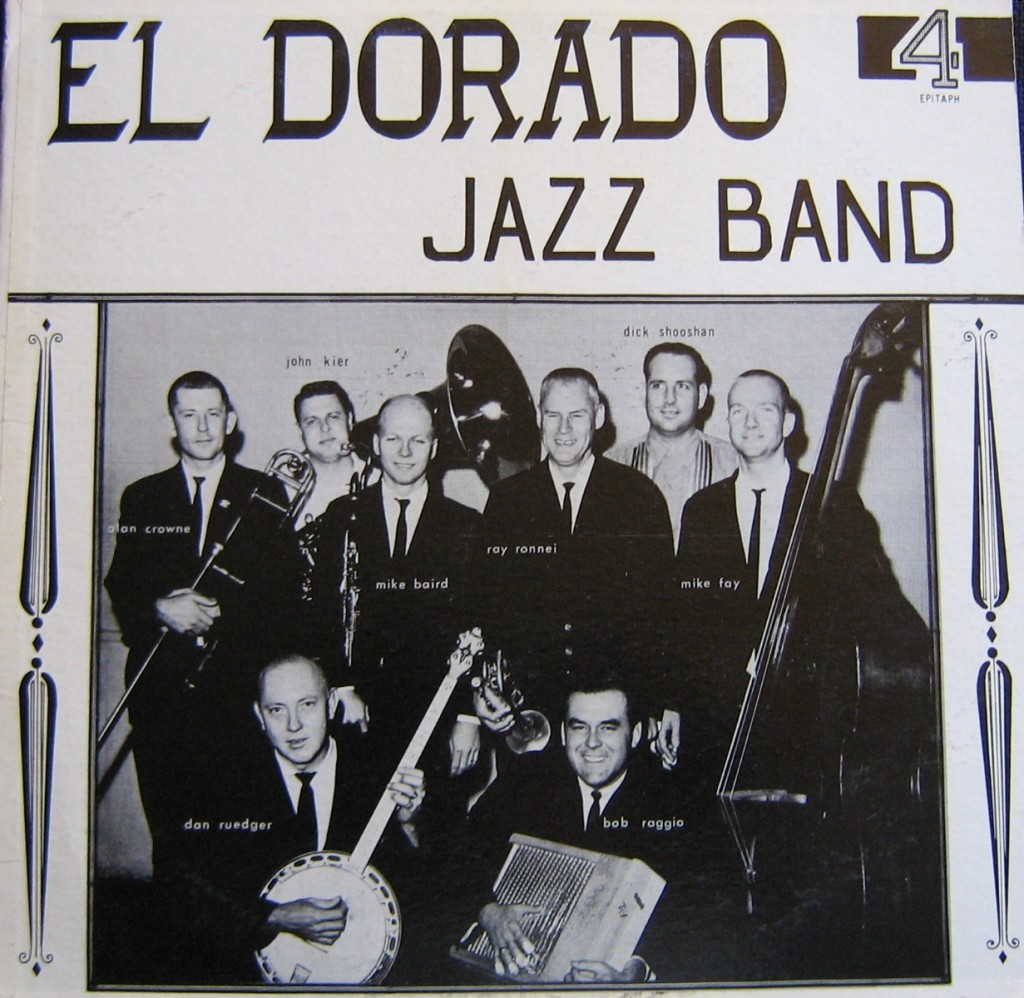
In late July of 1966, my family went to hear the South Frisco Jazz Band at the Pizza Palace in Huntington Beach. On the first intermission, I was talking with washboardist Bob Raggio, who played with both the El Dorado and South Frisco bands. Bob reached in his pocket and pulled out a business card, then handed it to me. The card read “EL DORADO JAZZ BAND – TRADITIONAL NEW ORLEANS JAZZ.” Bob said, “Here’s a collector’s item for you. The band played their final job last weekend.”
Thankfully I was at least able to enjoy the band’s unique sound on William Miskell’s Epitaph and Item-1 LPs. And as described in the February 2023 issue of The Syncopated Times, in 1967 I got to hear a version of the South Frisco Jazz Band with almost the same personnel as the El Dorado Jazz Band. What a thrill THAT was!
Fast-forward to 2008…I was the Special Projects Coordinator for the San Francisco Traditional Jazz Foundation. After working with the Foundation and the George H. Buck Jr. Jazz Foundation to produce two CDs of previously-unissued material by Bob Scobey’s Frisco Band and the Firehouse Five Plus Two, I convinced both groups to issue a CD by the El Dorado Jazz Band. I worked with The Foundation’s Curator, Clint Baker, to locate and listen to the El Dorado tapes in the Foundation’s archives. We considered a CD release of the material from the Epitaph LPs, but ultimately decided that previously-unissued tracks would be preferable. At the same time, Dave Radlauer, of the “Jazz Rhythm” radio program, had obtained live tapes of the band from the collection of Edward J. Sprankle. The sessions were originally recorded by Don Gibson and Pete Kier at Mr. Fat Fingers in Costa Mesa in 1964. We decided to select the best material from these tapes for GHB CD-510.
That’s the background. Now let’s talk about the music on that CD! First is the traditional New Orleans number “All The Girls Go Crazy.” Papa Ray Ronnei’s raggy cornet leads the way, while trombonist Al Crowne and clarinetist Mike Baird are the perfect front line partners. The rhythm played by banjoist Dan Ruedger, bassist Mike Fay and Bob Raggio on washboard is a force majeur. (I miss hearing Dick Shooshan on piano, but this is one killer rhythm section despite the absence of piano!) Dan Ruedger also regales us with a raw, shouting vocal. (Epitaph recordist/producer William Miskell described Dan Ruedger as “a skiffle Orpheus.”)
There’s a lot more to listen to on this CD, but did this first track make an impression on you, Jeff?
JB: Well, they’re not intending to take any prisoners! “All the Girls Go Crazy” exemplifies why this music was looked on as the party music of its day in parts of California, continuing a tradition inculcated by Mssrs. Watters and Murphy two decades earlier. I personally knew three of the members. I first heard Bob Raggio and Mike Baird during their appearances with the South Frisco Jazz Band in Connecticut in the 1980s-1990s. I knew Mike Fay primarily from his playing with YOU! Sadly, only Mike Baird remains with us. Raggio and Fay sounded exactly the same 30-40 years later (which was sublime) as they do on this date, and it’s so cool to catch Mike Baird channeling the real New Orleans clarinet sound of Johnny Dodds and others as opposed to his incorporating so many elements from Watters/Murphy reedman Bob Helm’s playing while performing with South Frisco.
Regarding the tune itself, the band’s FIVE opening ensembles on this 16-bar classic (the third chorus incorporating the second melody) forge ahead like a steam-roller! I hear another band member shouting the lyrics behind Dan Ruedger’s vocal (whose singing make me think of him as a West Coast Dave Van Ronk!) which leads into a Freddie Keppard-influenced cornet solo by Ray Ronnei. Then, we’re treated to some blues-drenched clarinet by Baird, with the addition of trombone Crowne for the second clarinet chorus that allows boneman Crowne to SHOUT into his Jim Robinson-inspired solo (at the start of which listen to the audience—and the band’s—reaction to Baird’s contribution). We emerge from this instrumental freight train into two more vocal choruses, serving as a palette change before FIVE outchoruses and the double ending that is a feature of West Coast—as opposed to New Orleans—Revival performance.
I have to say I miss pianist Dick Shooshan as well (you’ve kindly shared some sides with him in the band that I LOVE); nothing against Ruedger…he’s so forcefully keeping that incredible rhythm and pace going NON-STOP through the nearly six-minute performance that his banjo slips noticeably out-of-tune going into the fourth of the final five choruses. It’s just that an ensemble like this sounds a bit thin to me without the piano, especially on the more raucous numbers.
I’ll immediately contradict myself by commenting on the second track, “Straight Alky Blues.” Ruedger’s “street corner” delivery of the lyrics pungently pairs with his steady, sparse banjo accompaniment. Mike Fay’s rich, fat bass tone and effortless swing buoy the backing from clarinet and muted trombone on the first chorus, with Ronnei adding hot open horn during the next two vocal choruses. Ronnei continues into his solo chorus and I love how he leaves space between phrases. Baird’s clarinet outing is sinewy and snaky, with beautiful bluesy bent notes. Crowne’s two choruses show that one of his strengths is blowing hot over the blues changes. Throughout, Raggio is playing so subtly on the washboard (unusual to be able to include those two words in the same sentence) that your ears have to willfully search him out. Two more evocative vocals from Ruedger lead to two righteously howling ensembles out. What are your favorite elements of this track, Hal?
HS: Jeff, I can’t add anything to your description of “Straight Alky Blues,” but I would like to mention some attributes of the individual musicians. Ray Ronnei took lessons from a New Orleans master who we discussed in the previous two issues of The Syncopated Times: Papa Mutt Carey. Mutt was a great believer in “less is more” and had an incredibly soulful sound. His influence, combined with the inspirations of Freddie Keppard and Abbie Brunies, really shaped Ray’s approach to the horn. On some tracks you can hear echoes of Kid Ory and Turk Murphy in Al Crowne’s trombone playing. He heard both of them in person and on record. Al was a terrific cornetist, too—the regular hornman with the South Frisco for several years (and he played briefly with Turk). Mike Baird was one of the very best interpreters of Johnny Dodds’ music. His playing was always bright and exciting.
You mentioned Bob Raggio’s subtle washboard playing. With El Dorado, he employed more of a minimalist Baby Dodds/Jimmy Bertrand approach. With South Frisco he used different rhythm patterns and incorporated a woodblock and cowbell into his playing. I got to work with Dan Ruedger quite a bit in the Magnolia Jazz Band in the late 1970s. He was still playing that hard-driving style on banjo and shouting out the vocals the same way as he did in the 1960s. Mike Fay…what a pleasure to listen to that BIG sound on the bass, making the music move along without sounding forced. All these elements come together beautifully on “Tailgate Ramble.” I love that medium tempo, too. They left out part of the song but make up for it with some terrific playing—especially by Al Crowne. The intensity really builds on the last four choruses, and you can hear Mutt Carey, Freddie Keppard and Abbie Brunies in Ray’s cornet work.
On “Snag It” we hear additional musicians: John “Pete” Kier on helicon and Walter Sereth on drums. Pete played a lot of the El Dorado gigs, sometimes with string bass and other times as the only bass instrument. He and Mike always managed to avoid clashing! Walter also played clarinet with El Dorado and was one of the most subtle drummers in traditional jazz (fortunately, he is still with us). One band member is a mystery: the clarinetist. None of the surviving musicians remembered who was on this particular engagement. Whoever it is, he certainly played some terrific ensemble and solo work. Al Crowne’s trombone is redolent of “the Kid” on this track and here is our first vocal by “Papa Ray”—a distinctive, high-pitched voice. His interpretation of the King Oliver stoptime is sublime.
We have the same lineup on “Willie the Weeper.” Notice that the band used the “George Lewis” keys—D minor to F—instead of the “San Francisco” keys (F minor to Ab) or the Hot Seven’s G minor to Bb. It works! Also note the extremely bright tempo. I remember playing a tribute to the EDJB with Mike Baird back in 1995. After a couple of numbers, he turned to me and said, “Here we are, 30 years later, playing the same damn songs too damn fast!” The tempo seems to act as a stimulant in this case, with Dan Ruedger’s vocal and the horns sailing over the unstoppable rhythm. Before we shift to yet another combination of musicians, what do you hear on these numbers, Jeff?
JB: What I hear is some no-holds-barred excitement! And the tempo on “Tailgate” is perfect; I remember you sharing with me that this band rarely played anything in a medium tempo: it was usually either dirge-slow or rocket-fast. I had a belly laugh reading Mike Baird’s comment to you regarding tempo. In the early 1990s I first appeared on the festival scene with a Connecticut-based group called The Hot Cat Jazz Band. We played everything “too damn fast,” so much so that within a year the phrase “Connecticut-tempo” was coined!! I finally convinced that band to tone down the tempi after we finished our set at the Friday Harbor (Washington) Festival’s largest venue playing “Emperor Norton’s Hunch” (in a record 2 1/2 minutes) to clamorous response. The reason? The band that followed us was Grand Dominion (banjoist Mike Cox and clarinetist Walter Sereth in the group). They played a torrid nine-minute version of “Jelly Bean Blues” as their opening number to a warm (almost relieved) audience reaction. What a lesson that was!!!
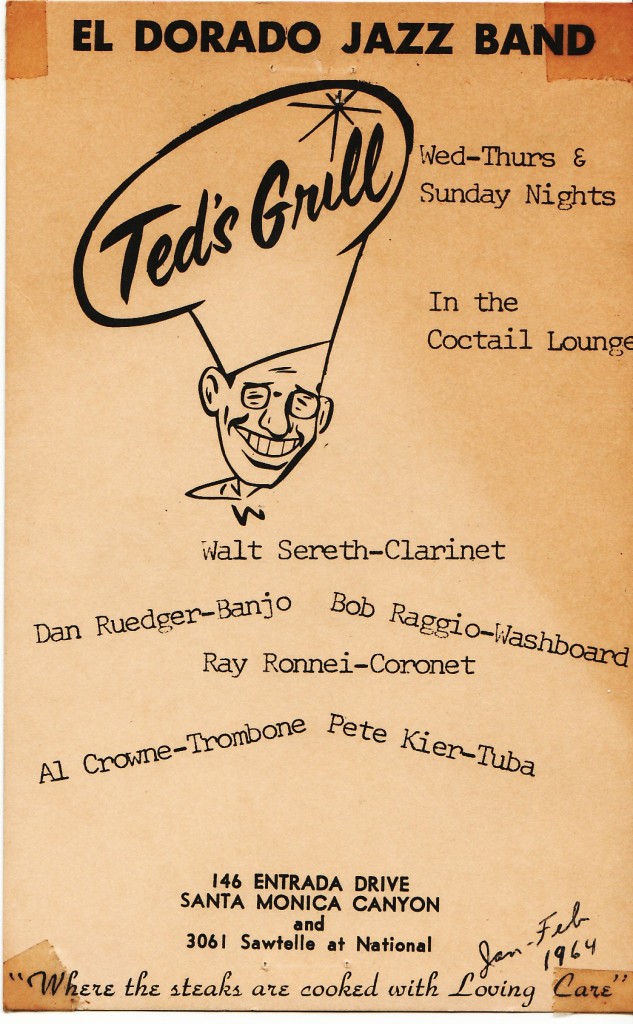
Coming back to “Tailgate,” the band gets off to a somewhat shaky start out of Dan Ruedger’s vocal pick-up but immediately locks in. Strutting trombone and clarinet backing to the vocal keep things stomping along. I wonder if lyricist Johnny Mercer and trumpeter/composer Wingy Manone ever heard El Dorado play their spirited version? Without exaggeration, Mike Baird’s solo is beautiful: an intoxicating mixture of soulful and hot!!! And, yes, I was out of my seat midway through the FOUR outchoruses!! This band must’ve been exceedingly popular to their live audiences.
At first, I was perplexed by the presence of BOTH brass and string bass as well as washboard AND drums on “Snag It,” but after a couple of listenings it made sense to me. First, Kier’s helicon and Fay’s bass were so solid, with neither overplaying, that there was room for them to support the ensemble without tripping over each other…could that ever happen with any band currently playing? As well, Raggio’s washboard created a pulsing susurration with a tambre that simply doesn’t exist on a drum kit, so he and Sereth could be simpatico. The audience acknowledgement of the “mystery clarinetist”’s facile solo—can we at least narrow down the possibilities of who this is? —shows a large and enthusiastic crowd! The audience really dug Ronnei’s vocal, and his ensuing cornet solo, cracks and all, is a work of art; the recording of this track shows a popular regional band at its height performing NOT for posterity, but for the sheer thrill of creating great sounds in front of enthusiastic patrons.
Hal, I can only think of The Galvanized and the New Black Eagle Jazz Bands on the East Coast that could generate that kind of excitement LIVE in a bar full of adoring fans. Fortunately for us, The Chicago Cellar Boys in Chicago and several groups in NYC are carrying on the tradition of bands playing OKOM at steady bar gigs and winning over a whole new legion of trad jazz fans!
There is lot to love about “Willie the Weeper!” Swinging brass bass from Kier, blazing lead from Ronnei, smearing accents by Crowne, a meltingly hot clarinet solo, Ronnei quoting Louis Armstrong’s 1927 solo with his Hot Seven and the audience’s explosive response! After Ruedger’s shouted vocal, a verse and then FOUR ensemble choruses out—the final one accentuated by Sereth’s almost savage choke cymbal—a double ending and everyone to the showers!
Hal, you mention a personnel change coming up. Does the heat continue?
HS: Well, it’s hot…but not “Willie the Weeper” hot! Incidentally, I really did try to figure out who the “mystery clarinetist” might be. I asked John Boland and John Smith, but when the track was played for each of them, they both said that it must have been someone else. I suggested Max Murray—a top Los Angeles jazz and swing pro—as a possibility, but the only response from the musicians I talked with was a shrug. If it was Joe Darensbourg, I think everyone would have remembered him. Oh, well…
The More the Merrier
The El Dorado Jazz Band was welcoming to guests. In fact, I have heard some recordings where there were more musicians in the rhythm section than in the front line! We will hear some of those performances in a bit, but first: Clark Huddleston was a frequent addition to the EDJB. He worked well with Dan Ruedger, especially when there was no piano. The two banjoists came up with different syncopated patterns, different phrasing, and even different chord inversions—but it worked. On “Down By the Riverside” you can really hear Clark alongside Dan Ruedger, making the rhythm section drive even more. Dan waits until the horns have soloed before singing, then the horns play multiple choruses, using dynamics as they build up to the outchorus. For me, Pete Kier’s helicon work is one of the highlights of this track.
“Make Me A Pallet On The Floor” has the same combination, but a lot more relaxed tempo! Once again, Dan Ruedger waits until the front line instruments and Pete Kier have soloed before singing. The vocal accompaniment by Mike Baird and Al Crowne is inspired.
What do you hear on these two sides, Jeff?
JB: I loved the great interplay between the front line musicians during “Down By The Riverside.” No-one overplays during the ensembles. There is so much attention to history here; why not two banjos? If it was a good sound for the Yerba Buena Jazz Band it works here, too. I also loved Pete Kier’s helicon contributions here…especially his walk-up leading us into the post-vocal ensembles. The band plays section one and then stays on the “chorus” section for a four-chorus ride out (this must’ve been at the very end of one of their nights; the smattering of applause suggests there were more people on the bandstand than in the audience!).
This band evidently loved playing ensemble, and of course that’s what separates this style from all other styles of jazz. I mentioned the attention to history. It’s as if they took all of the Revival traditions and sounds being produced across the country in the 1940s-’50s, threw in some of the older sounds of the 1920s-’30s, and emerged with this unique approach to the repertoire. My head’s fascinated by all of this even as my ears are delighted, and my feet are pooped from tapping so much.
I’ve always enjoyed “Pallet”and thought the tempo moderate for this band but it’s still faster than many other versions with which I’m familiar. To my ears, this sounds like the sextet line-up starts the tune and then the guests are added as the ride continues. I love hearing Baird’s clarinet solo, followed by its continuance with trombone added. There seem to be a few disagreements of what chords to play where here and there but this oddly doesn’t detract from the emotion of this side. Neither does the fact that the tune ends at a considerably faster tempo than it began. It was pure, it was sincere, and I loved it!
Hal, let’s wrap this edition up with some information about your new band and continue listening to more of the original group next month!
HS: Yes—let’s definitely listen to BCD-510 and write some more about that great music. Until someone with great musical taste reissues the Epitaph and Item-1 LPs, it’s all we have to share via YouTube links.
Thank you for the beautiful segue. In years past, I led El Dorado tribute groups—under other names—but finally decided to use the original band name for the latest incarnation. In 2023, the El Dorado Jazz Band played a set at Jazz Bash By the Bay in Monterey and one at the Redwood Coast Music Festival in Eureka. The band will perform at both of those events in 2024, and will debut at the Evergreen Jazz Festival in July and the Bix Beiderbecke Jazz Festival in August.
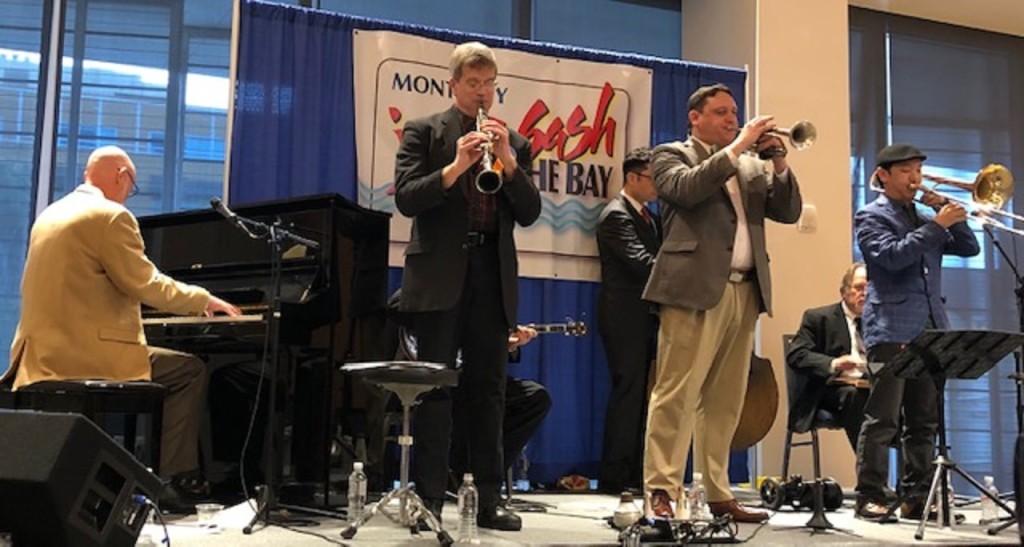
sets at the festival this year.
Our musicians are not just imitators, but everyone admires their counterparts in the band of 1964-1966: “Papa Ray” Ronnei, Al Crowne, Mike Baird, Dick Shooshan, Dan Ruedger, Mike Fay and Bob Raggio. We also appreciate the other musicians who played with El Dorado, such as Tom Sharpsteen, Walter Sereth, Frank Demond, Vic Loring and others. The present El Dorado Jazz Band is also blessed with several outstanding traditional jazz musicians who are available to play with us in case key band members are not available. I was thinking about this situation a few days ago and realized that we have exactly the same number of alternate musicians as the 1964 band! (Except for the fact that there are three cornetists who admire Papa Ray, Papa Mutt, Freddie Keppard, and Abbie Brunies who are available for our gigs)! The personnel on the bandstand may be slightly different from gig to gig, but it will always have that hot, driving approach to traditional jazz.
JB: And with you always at the helm! I’m honored to say that when schedules coincide, I’ll be in the piano chair and supplying some “shouted” vocals of my own! Can’t wait! More next month, dear readers. Remember: a washboard is good for more than just cleaning your socks!
Jeff Barnhart is an internationally renowned pianist, vocalist, arranger, bandleader, recording artist, ASCAP composer, educator and entertainer. Visit him online atwww.jeffbarnhart.com. Email: Mysticrag@aol.com
Hal Smith is an Arkansas-based drummer and writer. He leads the El Dorado Jazz Band and the
Mortonia Seven and works with a variety of jazz and swing bands. Visit him online at
halsmithmusic.com





